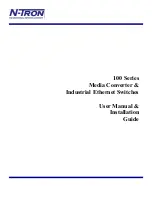
5000 Series Layer 2/3 Managed Data Center Switch CLI Reference Guide
167
810
hapiRxTask
0.00%
0.01%
0.01%
805
dtlTask
0.00%
0.02%
0.02%
863
spmTask
0.00%
0.01%
0.00%
894
ip6MapLocalDataTask
0.00%
0.01%
0.01%
908
RMONTask
0.00%
0.11%
0.12%
----------------------------------------------------------------
Total
CPU Utilization
1.55%
1.58%
1.50%
5-31
show running-config
This command is used to show or record the current settings of different protocol packages supported on
the switch. More specifically, it displays or records those commands with settings and configurations that
are different from the default values. To display or record those commands with settings and
configurations that remain equal to the default value, simply include the
all
option.
It should be noted that the Show running-config command does not show the User Password, even if one
different from the default has been set.
The output for the command is displayed in script format, and the output can then be used to configure
another switch with the same configuration. The output will be
redirected to a script file if the optional
scriptname
is provided with a file name extension of “.scr”.
Note:
If the
show running-config
command is issued from a serial connection, access to the switch via
remote connections (such as Telnet) will be suspended as the output is being generated and shown.
Note:
If a text-
based configuration file is used, then the
show running-config
command will only show
the configured physical interfaces. That is, if any interface contains only
the default configuration, then
that interface will be skipped when generating the
show running-config
command output. (This is true,
in fact, for any configuration mode for which nothing but the default configuration is used.) In other words,
the
command to enter a particular config mode, as well as its exit command, are both omitted from the
generated
show running-config
command output. As a result, they are omitted from the startup-config
file when the configuration for the system is saved.
The following keys should be used to navigate the command output.
Key
Action
Enter
Advances one line.
Space Bar
Advances one page.
q
Stops the output and returns to the prompt.
It should be noted that
--More--
or
(q)uit
is shown at the bottom of the output screen until the user
reaches the end of the output.
This command is used to display the current settings for the OSPFv2 trapflag status:
•
ln the event that all the flags are enabled, then
trapflags all
will be displayed by the command.
•
ln the event that all the flags in a specific group are enabled, then the command will cause the
trapflags
group name all
to be displayed.
•
If only some but not all of the flags in said group are enabled, the command will cause the
trapflags
groupname flag-name
to be displayed.
show running-config [all | interface | vpc | scriptname]
















































